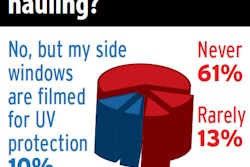 George Spears, who had no health problems from sun exposure during his career with Carlile Transportation in Alaska, recalls a fellow driver who had skin grafts to treat skin cancer on his left arm. The driver later died from other causes. Spears starred in one season of “Ice Road Truckers” before retiring in 2009 to his family home in Greenup, Illinois.
George Spears, who had no health problems from sun exposure during his career with Carlile Transportation in Alaska, recalls a fellow driver who had skin grafts to treat skin cancer on his left arm. The driver later died from other causes. Spears starred in one season of “Ice Road Truckers” before retiring in 2009 to his family home in Greenup, Illinois.Joe Jolly started trucking in the early 1980s when the risks of frequent direct exposure to the sun’s ultraviolet radiation weren’t quite as well understood as they are today.
That goes for the risks to drivers, too, though one might assume they largely are protected by being inside a cab. Fact is, though the roof blocks the sun, and glass in general blocks a substantial amount of what’s long been thought to be the most damaging type of ultraviolet radiation, glass doesn’t get it all.
Among the give-or-take 2 million skin cancers diagnosed annually in the United States, the Skin Cancer Foundation has noted that well more than half occur on the left side of the body — the side, of course, most exposed to solar radiation behind the wheel.
Reporting on a study conducted by St. Louis-based researchers, the foundation noted that 53% of skin cancers in the United States occur on the left side. In the case of the most typically aggressive skin cancer, melanoma, 74% of all occurrences of it that had not yet become invasive were on the left, the study noted. That result suggested that glass-penetrating forms of UV radiation could well be the reason.
Jolly, of Ft. Scott, Kansas, is today among an unknown number of truckers and former truckers now living with the legacy of a cancer diagnosis. The former trucker drove for nearly three decades stretching back to the early 1980s.

Early this year, “I was shaving, and right along the edge of my upper lip, I cut it,” Jolly says. The cut “got bigger, and it wouldn’t heal.”
During a routine medical visit days later, the doctor remarked that indeed it looked like Jolly had cut himself shaving and that he should keep an eye on it. Weeks later, “It was getting bigger and was not healing at all, and it itched a lot,” Jolly says.
His doctor referred him to a specialist in Pittsburg, Kansas, who diagnosed the condition as squamous cell carcinoma, one of the more common variants of skin cancer. When removed early, it comes with a generally good prognosis.
Jolly, who had assumed skin cancer was for people totally exposed to the sun all day, recalls telling the doctor, “I was in the cab of a truck my whole career. The sun wasn’t on me.” She came back, “It wasn’t on you, but it was on you. It will find you.”
He soon had the spot removed. The doctor gave him a 95% chance of living the next five years with no complications. “I like those odds,” he says, but “I don’t like that 5%.”
 In separate editions of the Overdrive Radio podcast this summer, former trucker Joe Jolly and 40-year independent owner-operator Ingrid Brown shared their skin cancer stories. Brown has gotten checkups for melanoma every few months and had more than one cancer removed in the past. Two were on the left side of her face. In her early trucking years, she says, “I never threw sunscreen on my left arm, I never put it on my face.” She does today. “Believe me, it’s worth it.”
In separate editions of the Overdrive Radio podcast this summer, former trucker Joe Jolly and 40-year independent owner-operator Ingrid Brown shared their skin cancer stories. Brown has gotten checkups for melanoma every few months and had more than one cancer removed in the past. Two were on the left side of her face. In her early trucking years, she says, “I never threw sunscreen on my left arm, I never put it on my face.” She does today. “Believe me, it’s worth it.”Squamous and basal cell carcinomas are the most common forms of skin cancer and not likely to spread quickly to other organs. That’s unlike the deadliest form, malignant melanoma, faced by Trucker Nation Communications Director Andrea Marks, who comes from a trucking family.
“I am living proof that melanoma is, in fact, curable,” she says, after being diagnosed in 2007 with the stage 4 malignant form of the cancer. It “had spread to lymph nodes in my neck, under both my arms, behind my belly button and in my groin. After 11 surgeries, 368 days of chemo and immunotherapy, I am cancer-free.”
The Skin Cancer Foundation details the difficulty of treating melanoma when it’s spread like this. Caught early, though, even melanoma “is almost always curable,” the foundation says.
Marks underscores the widespread nature of the risks. “While sun exposure, organic or manmade, is a real melanoma risk, there is both a random and genetic component to this form of cancer,” she says, “Everyone – dockworkers, dispatchers, drivers’ wives and kids, office workers – they all need to be educated on all the risks.”
Jolly concurs. It’s why he reached out to Overdrive about his diagnosis. “If you’re going to be sitting there bouncing down the road all day, you better get something on your skin to protect you from the ultraviolet rays,” he says. While drivers may think they’re in the shade, the sun “will find you.”
He urges drivers with any kind of sore on their arms or face that’s not healing to see a dermatologist. Those who’ve had skin cancer in their family’s history, too, should consult their regular physician about how often to get a dermatology screening, a key preventive measure.
Next in this series: Cancer prevention: Use sunscreen on exposed skin










